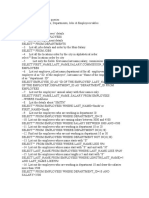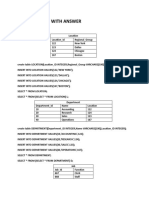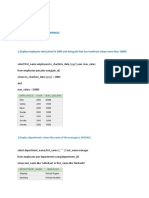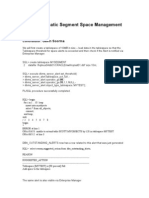0% found this document useful (0 votes)
175 views10 pagesSample Queries
The document contains SQL queries to retrieve employee, department, job, and location data from various database tables. The queries select, filter, sort, group, and join data using clauses like WHERE, ORDER BY, GROUP BY, HAVING, and JOIN. They retrieve specific records, counts, and aggregations and perform operations like updating records and deleting records using subqueries.
Uploaded by
Tejas deshpandeCopyright
© © All Rights Reserved
We take content rights seriously. If you suspect this is your content, claim it here.
Available Formats
Download as DOC, PDF, TXT or read online on Scribd
0% found this document useful (0 votes)
175 views10 pagesSample Queries
The document contains SQL queries to retrieve employee, department, job, and location data from various database tables. The queries select, filter, sort, group, and join data using clauses like WHERE, ORDER BY, GROUP BY, HAVING, and JOIN. They retrieve specific records, counts, and aggregations and perform operations like updating records and deleting records using subqueries.
Uploaded by
Tejas deshpandeCopyright
© © All Rights Reserved
We take content rights seriously. If you suspect this is your content, claim it here.
Available Formats
Download as DOC, PDF, TXT or read online on Scribd
/ 10



















































































